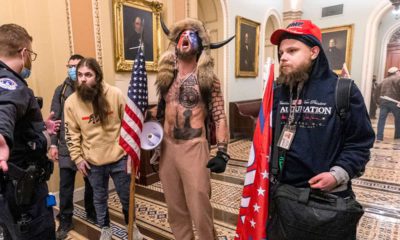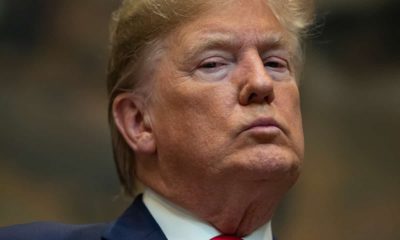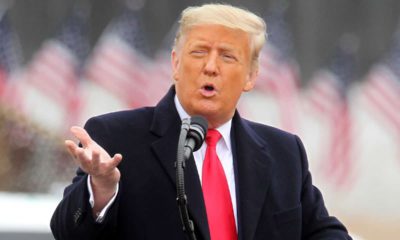Analysis
Fact Check: Trump's Falsehoods on Electoral College, Border Wall
Published
5 years agoon
By
AP News
WASHINGTON — An eye toward his 2020 campaign, President Donald Trump is turning to a familiar playbook of exaggerated boasts about economic performance and overdrawn complaints about a race tilted against him.
He insisted the Electoral College gives Democrats a “big advantage” in U.S. presidential elections, making it difficult for Republicans like himself to win. That’s wrong. Though in 2016 he often described the election as “rigged” against him, Trump, in fact, wouldn’t have won the presidency without the Electoral College system in which the votes of smaller rural states that tend to vote Republican are weighted more heavily than big, Democratic-leaning states like New York and California.
Trump also claimed over the weekend that he’s presided over one of the best U.S. economies ever. He’s wrong about that, too.
The misleading rhetoric over the past week came as the president prepared to kick off his re-election campaign Tuesday in Florida.
In Trump’s reckoning, an Iran tamed by him no longer cries “death to America,” the border wall with Mexico is proceeding apace, the estate tax has been lifted off the backs of farmers, the remains of U.S. soldiers from North Korea are coming home and China is opening its wallet to the U.S. treasury for the first time in history. These claims range from flatly false to mostly so.
Here’s a look:
Electoral College
Trump, in part addressing polls finding him lagging some of the 2020 Democratic candidates: “It’s always tougher for the Republican because, you know, I don’t know, people — people never cover this, but the Electoral College is very much steered to the Democrats. It’s a big advantage for the Democrats. It’s very much harder for the Republicans to win.” — Fox News interview Friday.
THE FACTS: Actually, the Electoral College’s unique system of electing presidents is a big reason why Trump won the presidency. Four candidates in history, including Al Gore in 2000, have won a majority of the popular vote only to be denied the presidency by the Electoral College. All were Democrats.
In the 2016 election, Democrat Hillary Clinton received nearly 2.9 million more votes than Trump after racking up more lopsided victories in big states such as New York and California, according to election data compiled by The Associated Press. But she lost the presidency due to Trump’s winning margin in the Electoral College, which came after he narrowly won less populous Midwestern states such as Michigan and Wisconsin.
Unlike the popular vote, Electoral College votes are set equal to the number of U.S. representatives in each state plus its two senators. That means more weight is given to a single vote in a small state than the vote of someone in a large state.
Economy and Taxes
Trump: “No President has done what I have in … the first 2 1/2 years of his Presidency, including the fact that we have one of the best Economies in the history of our Country.” — tweets Saturday.
The economy expanded at an annual rate of 3.2 percent in the first quarter of this year. That growth was the highest in just four years for the first quarter.
In the late 1990s, growth topped 4 percent for four straight years, a level it has not yet reached on an annual basis under Trump. Growth even reached 7.2 percent in 1984.
While the economy has shown strength, it grew 2.9% in 2018 — the same pace it reached in 2015 — and simply hasn’t hit historically high growth rates.
Trump: “Wages are growing, and they are growing at the fastest rate for — this is something so wonderful — for blue-collar workers. The biggest percentage increase — blue-collar workers.” — remarks Tuesday in Council Bluffs, Iowa.
THE FACTS: He’s claiming credit for a trend of rising wages for lower-income blue-collar workers that predates his presidency.
Some of the gains also reflect higher minimum wages passed at the state and local level; the Trump administration opposes an increase to the federal minimum wage.
With the unemployment rate at 3.6%, the lowest since December 1969, employers are struggling to fill jobs. Despite all the talk of robots and automation, thousands of restaurants, warehouses, and retail stores still need workers.
They are offering higher wages and have pushed up pay for the lowest-paid one-quarter of workers more quickly than for everyone else since 2015. In April, the poorest 25% saw their paychecks increase 4.4% from a year earlier, compared with 3.1% for the richest one-quarter.
Those gains are not necessarily flowing to the “blue collar” workers Trump cited. Instead, when measured by industry, wages are rising more quickly for lower-paid service workers. Hourly pay for retail workers has risen 4.1% in the past year and 3.8% for hotel and restaurant employees. Manufacturing workers — the blue collars — have seen pay rise just 2.2% and construction workers, 3.2%.
Trump: “And to keep your family farms and ranches in the family, we eliminated the estate tax, also known as the ‘death tax,’ on the small farms and ranches and other businesses. That was a big one. … People were having a farm, they loved their children, and they want to leave it to their children. … And the estate tax was so much, the children would have to go out and borrow a lot of money from unfriendly bankers, in many cases. And they’d end up losing the farm, and it was a horrible situation.” — remarks in Council Bluffs.
THE FACTS: There still is an estate tax. More small farms may be off the hook for it as a result of changes by the Republican-controlled Congress in 2017 but very few farms or small businesses were subject to the tax even before that happened.
Congress increased the tax exemption — temporarily — so fewer people will be subject to those taxes.
Previously, any assets from estates valued at more than $5.49 million, or nearly $11 million for couples, were subject to the estate tax in 2017. The new law doubled that minimum for 2018 to $11.2 million, or $22.4 million for couples. For 2019, the minimums rose to $11.4 million, or $22.8 million for couples. Those increased minimums will expire at the end of 2025.
According to an analysis by the nonpartisan Tax Policy Center, only about 80 small farms and closely held businesses were subject to the estate tax in 2017. Those estates represent about 1 percent of all taxable estate tax returns.
Russia Investigation
Trump, on special counsel Robert Mueller’s report: “He said no collusion. … The report said no collusion.” — ABC News interview aired Sunday.
Trump: “The Mueller report spoke. … It said, ‘No collusion and no obstruction and no nothing.’ And, in fact, it said we actually rebuffed your friends from Russia; that we actually pushed them back — we rebuffed them.” — remarks Wednesday in Oval Office.
THE FACTS: He’s wrong to repeat the claim that the Mueller report found no collusion between Russia and the Trump campaign; it’s also false that his campaign in 2016 denied all access to Russians. Nor did the special counsel’s report exonerate Trump on the question of whether he obstructed justice.
On collusion, Mueller said he did not assess whether that occurred because it is not a legal term.
He looked into a potential criminal conspiracy between Russia and the Trump campaign and said the investigation did not collect sufficient evidence to establish criminal charges on that front.
Mueller noted some Trump campaign officials had declined to testify under the Fifth Amendment or had provided false or incomplete testimony, making it difficult to get a complete picture of what happened during the 2016 campaign. The special counsel wrote that he “cannot rule out the possibility” that unavailable information could have cast a different light on the investigation’s findings.
In his interview with ABC News, Trump said if a foreign power offered dirt on his 2020 opponent, he’d be open to accepting it and that he’d have no obligation to call in the FBI. “I think I’d want to hear it,” Trump said. “There’s nothing wrong with listening.”

Special counsel Robert Muller speaks May 29 about the Russia investigation. (AP Photo/Carolyn Kaster)
THE FACTS: Graham is making an unequal comparison.
He seeks to turn the tables on Democrats by pointing to their use of a dossier of anti-Trump research produced by Christopher Steele, a former British intelligence officer, that was financed by the Democratic Party and Hillary Clinton’s campaign. Graham also insists on “equal outrage” over Democrats using that information from a former intelligence officer of Britain, an ally with a history of shared intelligence with the U.S. That’s a different story from a foreign adversary such as Russia, which the Mueller report concluded had engaged in “sweeping and systematic” interference in the 2016 presidential election.
Moreover, Steele was hired as a private citizen, though one with intelligence contacts.
The Mueller report found multiple contacts between the Trump campaign and Russia, and the report said it established that “the Russian government perceived it would benefit from a Trump presidency and worked to secure that outcome, and that the Campaign expected it would benefit electorally from information stolen and released through Russian efforts.”
Trump and his GOP allies typically point to the Steele dossier as the basis for the Russia probe. But the FBI’s investigation began months before it received the dossier.
Trump: “What kind of a rigged deal is this? And then on top of it, after two years and after being the most transparent in history…” — ABC News interview aired Sunday.
Trump: “The Democrats were very unhappy with the Mueller report. So now they’re trying to do a do-over or a redo. And we’re not doing that. We gave them everything. We were the most transparent presidency in history.” — Oval Office remarks Wednesday.
THE FACTS: It’s highly dubious to say Trump was fully cooperative in the Russia investigation.
Trump declined to sit for an interview with Mueller’s team, gave written answers that investigators described as “inadequate” and “incomplete,” said more than 30 times that he could not remember something he was asked about in writing, and — according to the report — tried to get aides to fire Mueller or otherwise shut or limit the inquiry.
In the end, the Mueller report found no criminal conspiracy between the Trump campaign and Russia but left open the question of whether Trump obstructed justice.
According to the report, Mueller’s team declined to make a prosecutorial judgment on whether to charge partly because of a Justice Department legal opinion that said sitting presidents shouldn’t be indicted. The report instead factually laid out instances in which Trump might have obstructed justice, specifically leaving it open for Congress to take up the matter.
Iran
Trump, speaking about Iranians “screaming ‘death to America'” when Barack Obama was in the White House: “They haven’t screamed ‘death to America’ lately.” — Fox News interview Friday.
THE FACTS: Yes they have. The death-to-America chant is heard routinely.
[rlic_related_post_three]
The chant, “marg bar Amreeka” in Farsi, dates back even before Iran’s 1979 Islamic Revolution. Once used by communists, it was popularized by Ayatollah Ruhollah Khomeini, the revolution’s figurehead and Iran’s first supreme leader after the U.S. Embassy takeover by militants.
It remains a staple of hard-line demonstrations, meetings with current Supreme Leader Ayatollah Ali Khamenei, official ceremonies, parliamentary sessions and main Friday prayer services in Tehran and across the country. Some masters of ceremonies ask audiences to tone it down. But it was heard, for example, from the crowd this month when Khamenei exhorted thousands to stand up against U.S. “bullying.”
In one variation, a demonstrator at Tehran’s Quds rally last month held a sign with three versions of the slogan: “Death to America” in Farsi, “Death to America” in Arabic,” ”Down with U.S.A.” in English.
North Korea
Trump: “I think we’re going to do very well with North Korea over a period of time. I’m in no rush. … Our remains are coming back; you saw the beautiful ceremony in Hawaii with Mike Pence. We’re getting the remains back.” — joint news conference Wednesday with Poland’s president.
With U.S.-North Korea relations souring, the Pentagon said last month it had suspended its efforts to arrange negotiations this year on recovering additional remains of American service members. The Pentagon said it hoped to reach agreement for recovery operations in 2020.
[rlic_related_post_two] The Defense POW-MIA Accounting Agency said it has had no communication with North Korean authorities since the Vietnam summit between Trump and North Korean leader Kim Jong Un in February. That meeting focused on the North’s nuclear weapons and followed a June 2018 summit where Kim committed to permitting a resumption of U.S. remains recovery; that effort had been suspended by the U.S. in 2005.
The agency said it had “reached the point where we can no longer effectively plan, coordinate, and conduct field operations” with the North during this budget year, which ends Sept. 30.
Last summer, in line with the first Trump-Kim summit in June, the North turned over 55 boxes of what it said were the remains of an undetermined number of U.S service members killed in the North during the 1950-53 war. So far, six Americans have been identified from the 55 boxes.

President Donald Trump meets North Korean leader Kim Jong Un in February. (AP Photo/ Evan Vucci)
Border Wall
Trump: “The wall is going up. It’s going up rapidly. We’re going to have over 400 miles of wall built by the end of next year … And we just won the lawsuit on the wall.” — Fox News interview Friday.
Trump: “By next year, at the end of the year, we’re going to have close to 500 miles of wall.” — remarks Tuesday at the Republican Party of Iowa annual dinner.
THE FACTS: He’s being overly optimistic. It’s unclear how Trump arrives at 400 to 500 miles (800 km), but he would have to prevail in legal challenges to his declaration of a national emergency or get Congress to cough up more money to get anywhere close. Those are big assumptions. And by far the majority of the wall he’s talking about is replacement barrier, not new miles of construction.
So far, the administration has awarded contracts for 247 miles (395 km) of wall construction, but more than half comes from Defense Department money available under Trump’s Feb. 15 emergency declaration. On May 24, a federal judge in California who was appointed by Obama blocked Trump from building key sections of the wall with that money. In a separate case, a federal judge in the nation’s capital who was appointed by Trump sided with the administration , but that ruling has no effect while the California injunction is in place.
Even if Trump prevails in court, all but 17 miles (27 km) of his awarded contracts replace existing barriers.
The White House says it has identified up to $8.1 billion in potential money under the national emergency, mostly from the Defense Department.
Customs and Border Protection officials say the administration wants Congress to finance 206 miles (330 km) next year. The chances of the Democratic-controlled House backing that are between slim and none.
Trade
Trump: “Right now, we’re getting 25% on $250 billion worth of goods. That’s a lot of money that’s pouring into our treasury. We’ve never gotten 10 cents from China. Now we’re getting a lot of money from China.” — remarks on June 10 with Indianapolis 500 champions.
Trump: “We’re taking in, right now, billions and billions of dollars in tariffs, and they’re subsidizing product.” — remarks Tuesday in Council Bluffs.
THE FACTS: He’s incorrect. The tariffs he’s raised on imports from China are primarily if not entirely a tax on U.S. consumers and businesses, not a source of significant revenue coming into the country.
A study in March by economists from the Federal Reserve Bank of New York, Columbia University and Princeton University, before the latest escalation, found that the public and U.S. companies were paying $3 billion a month in higher taxes from the trade dispute with China, suffering $1.4 billion a month in lost efficiency and absorbing the entire impact.
It’s also false that the U.S. never collected a dime in tariffs before he took action. Tariffs on goods from China are not remotely new. They are simply higher in some cases than they were before. Tariffs go back to the beginning of the U.S. and were once a leading source of revenue for the government. Not in modern times. They equate to less than 1% of federal spending.
Federal Reserve
Trump: “We have people on the Fed that really weren’t, you know, they’re not my people, but they certainly didn’t listen to me because they made a big mistake.” — CNBC interview on June 10.
THE FACTS: Actually, most of the members on the Fed’s Board of Governors owe their jobs to Trump.
In addition to choosing Jerome Powell, a Republican whom Obama had named to the Fed board, to be chairman, Trump has filled three other vacancies on the board in his first two years in office. Lael Brainard is the only Democrat on the board.
There are still two vacancies on the seven-member board. Trump had earlier intended to nominate two political allies — Herman Cain and Stephen Moore — but both later withdrew in the face of sharp opposition from critics.

Federal Reserve Chairman Jerome Powell speaks June 4 at a conference involving its review of its interest-rate policy strategy and communications. (AP Photo/Kiichiro Sato)
You may like
-


No-Go for Joe Exotic: Trump Pardon List Omits ‘Tiger King’
-


Trump Pardons Ex-Strategist Steve Bannon, Dozens of Others
-


Long Shot? Capitol Rioters Hold Out Hope for a Trump Pardon
-


‘Shameful’: US Virus Deaths Top 400k as Trump Leaves Office
-


Federal Court Strikes Down Major Trump Climate Rollback
-


Trump Expected to Issue Flurry of Pardons on Last Full Day











